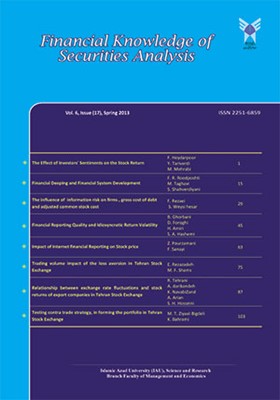Dynamic correlation between oil price, financial transparency and stock crash risk; using the Panel VAR model
Subject Areas : Financial Knowledge of Securities Analysiszahra taleii 1 , Mohammad Reza Pourali 2 , Seyed Fakhreddin Fakhrhossseini 3
1 - PHD Student in Accounting, Department of Accounting, Tonekabon Branch, Islamic Azad University, Tonekabon , Iran
2 - Associate Professor of Accounting, Department of Accounting, Chalous Branch, Islamic Azad University, Iran
3 - Associate Professor of Economics, Department of Accounting, Tonkabon Branch, Islamic Azad University, Tonkabon, Iran
Keywords: oil price, financial transparency , stock crash risk , PVAR model,
Abstract :
This study has aimed to examine the dynamic correlation between oil price, financial transparency and stock crash risk and PVAR model for oil and petrochemical companies in 2014 to 2022. Based on the estimation results of the PVAR model, an impulse from the oil price and the exchange rate on the risk of falling stock prices up to the first two periods; It goes down and then up. In terms of whether they are oil importers or exporters, countries have different effects on oil price changes. Oil producing countries are forced to secure their foreign exchange income due to their economic structure, and when prices fall, they try to increase production to increase their income. In oil exporting countries, any increase in oil prices is expected to lead to an increase in income in these countries. The increase in the government's income and wealth causes future cash flows to increase, as a result, it has a positive effect on the capital market and, accordingly, the stock index, and the risk of falling stock prices is reduced. Since the stock market returns are one of the most accurate tools shown in the economy and has a high sensitivity to economic conditions and can have a direct effect on the interest rate and people's trust, policy makers always adopt policies for financial transparency and the quality of information disclosure to provide the basis for the development of this market as much as possible.
بهرامي جاويد، محمدي تيمور، بزرگ شادي، (1393)، انتقال نامتقارن نرخ ارز به شاخص¬هاي قيمت داخلي با رويکرد SVAR، فصلنامه پژوهش هاي اقتصادي ايران، شماره 40، صص 65-37.
پورعلی ، محمدرضا و آروین ، راضیه. (1396)،"بررسی شفافیت سود با ریسک نقدشوندگی سهام "کنفرانس ملی تحقیقات علمی جهان در مدیریت ،حسابداری،حقوق و علوم اجتماعی
پورعلی، محمدرضا و حمیدرضا، جنت فریدونی.(1400)"بررسی رابطه بین رفتار تجاری سرمایه گذار و ریسک سقوط قیمت سهام به ریسک فردی" دومین کنفرانس بین المللی چالشها و راهکارهای نوین در مهندسی صنایع و مدیریت حسابداری
پيرايي خسرو ، حسين کوروش پسنديده(1380)، "مطالعه تجربي رابطه بين تورم و نرخ ارز در ايران"، پژوهشنامه علوم انساني و اجتماعي، سال اول، شماره 4، صص 81-63.
خوشبخت ،آمنه و اخباري، محمد. (1386)، بررسي فرآيند اثرگذاري تغييرات نرخ ارز بر تورم شاخص¬هاي قيمت مصرف¬کننده و واردات در ايران، پژوهشنامه اقتصادي، شماره 10، صص 82-51.
سادات اخوي، سيد محمدو حسيني ،سيد شمس الدين. (1396)، ارزيابي تاثير تحريم هاي اقتصادي بر تورم اقتصاد ايران، فصلنامه اقتصاد کاربردي، شماره 21، صص 50-33.
کاشانی،فواد و علیزاده طلاتپه وحید(1390) بررسی اثرات سطح افشای داوطلبانه بر عدم تقارن اطلاعاتی شرکت های پذیرفته شده در بورس اوراق بهادار تهران مطالعات تجربی حسابداری مالی دوره 11 شماره 42 ص 89 144
منصوري نجف آبادي نسرين، تيمور محمدي (1388)، "بررسي رابطه متقابل بين تورم، بيکاري و تغييرات نرخ ارز با استفاده از روش خود گرسيوني برداري (VAR)"، دانشگاه آزاد اسلامي. واحد تهران مرکزي.
نصیری، مهراب و فخاری، حسین(1399) تاثیر عملکرد شرکت بر ریسک سقوط آتی قیمت سهام نشریه مدیرت راهبرد مالی دوره 8 شماره 30 ص 43 تا 62
Berg, A., Karam, P., and Laxton, D. (2006). Practical model-based monetary policy analysis—a how-to guide. International Monetary Fund Working Paper, 06/81
Chang, Roberto (2018), Foreign Exchange Intervention Redux, NBER Working Paper No. 24463, Issued in March 2018, NBER Program(s): International Finance and Macroeconomics, Monetary Economics
Denis, S (2021) Detecting GAAP Violation: Implication for Assessing Earning Managementamong Firms with Extreme Financial Performance. Journal of Accounting and Public Policy,16(3), 271-309.
Ken, B (2020)., & Kaufmann D Toward Transparency:New Approaches and TheirApplication to Financial. The World Bank Research Observer, 16, 41-57
Kubo, A. (2015). Did central banks respond to currency depreciation during the global financial crisis? Mimeo.
Kubo, A. (2017). Macroeconomic impact of monetary policy shocks: Evidence from recent experience in Thailand. Journal of Asian Economics, 19(1), 83–91
Loyz, A (2021) Association between outsiderDirectors and InstitutionalInvestors and the Properties of
Management Earning Forecast.Journal Of Accounting Research,43, 343-376
Ripoll M. (2016). Real Exchange Rate Targeting, Macroeconomic Performance, and Sectoral Income Distribution in developing Countries” Journal of Trade & Economic Development, Vol. 14, pp. 167-196.


